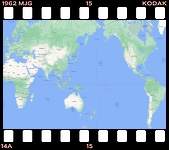On 12th February Raul’s hostel provided a decent breakfast, after which I checked out, and headed to the centre of Puerto Montt to make some photocopies of my diary – I had been a bit behind with this task, and there’s always the fear that I might suddenly lose the original. The photocopies duly sent off to the UK, I then headed to the bus terminal and after a long wait got on a bus for the island of Chiloé. This 200 km long island is said to be “Chile on steroids” – all the characteristics of Chile (friendly people, beautiful rural scenery, unspoiled coastlines, delicious seafood) but even more so than normal!
A 5 km ferry crossing carried the bus to the island, after which we headed down to Castro in improving weather. By the time I’d got some maps from Castro tourist info, and found an onward bus to my destination of Chonchi, it was quite hot – I’d mistakenly thought that it would feel cool so close to the southern tip of South America. In Chonchi the jocular and helpful tourist office sent me to a great little hostel – in a traditional and typical wooden house. I headed out on a food hunt and ate a barros luco sandwich on the sea front, while watching my first wild penguin swimming around in the little harbour.
It appears that 100% of the buildings in Chonchi are wood construction – I noticed a house that was half-built, with just the wood frame visible, which was interesting to see. It looked rather flimsy, but evidently the architectural style works well. I remembered that my sister in Houston told me that even the brick houses in Houston have a wooden frame to support the whole structure – this seems strange to a European who is used to buildings being built of “mineral” – brick, stone, concrete etc.
Back at the hostel I caught up on postcard writing and had an early night.
On 13th February I had a slow start, enjoying a leisurely breakfast in the hostel with a German girl who mentioned the island of Lemuy (to the south east) as being a place where many people go. I went to investigate ferry times to Lemuy, and decided that I’d head for Lemuy the same day. I went down to the sea front again, and wandered along taking photos. Many houses to the south of the end of the sea wall seemed to have been built on stilts directly on the beach…
I then headed off down the the dirt road to the south, hoping I might hitch a ride, but since it was only 4 km to the ferry to Lemuy, I was quite happy to walk. The little ferry was there as promised, but I had to wait half an hour.
While waiting, I got chatting to another backpacker, Maria-Lisa from Valencia in Spain. I had imagined that I was being adventurous by heading to a smaller island having come to the island of Chiloé, but this intrepid young lady was island-hopping eastwards on increasingly small and remote islands, planning to arrange ad-hoc boat trips, as and when necessary if there were no regular ferries. She said there were 4 more islands on the way to reaching the mainland of Chile at a place called Chaitén. From there the carretera austral (southern highway), a road system isolated from the rest of Chile, continues south for 900 km through the Patagonian wilderness. I began to wish I had the option of going too… but I already have my plane ticket from Puerto Montt to Punta Arenas. Next time, maybe…
As we crossed the channel to Lemuy, Maria-Lisa found a pickup driver willing to take us to the village of Puqueldón – the main town on the island. There I found a pension – Maria-Lisa said she’d try to get to the next island the same day if possible. We had lunch and then started walking east towards a little village on the east coast called Puchilco, from where Maria-Lisa thought she could find a boat. After walking for a couple of km we got a ride the rest of the way and then were able to locate a launch for her that would be leaving in about 2 hours.
It was a warm afternoon, and a beautiful location, and we sat on the beach soaking up the tranquility and remoteness. Maria-Lisa produced a bottle of apple wine which apparently improved my Spanish sufficiently that she decided we’d then speak in Spanish rather than English! Eventually it was time to say farewell.
I walked north along the beach and soon got chatting to a friendly Chilean family who were staying, as it later turned out, in the same pension as me in Puqueldón. They were barbecuing on the beach and invited me to share salmon and [yet more] wine with them.
Then the sun dipped towards the horizon and it was time to go – the family had a car parked half a km up from the beach and had enlisted the help of a local man with 2 cows and a sled, to take their beach things down and later back again. The cows duly dragged the load back to the car, which was parked near an old and beautiful wooden church which I then poked my nose in.
Then they gave me a ride back to Puqueldón and the pension. After heading out for a quick sandwich I got my diary up to date again.

